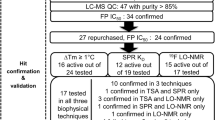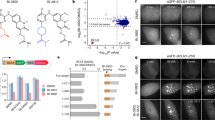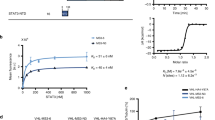Abstract
BCL-6 is a transcription factor essential for germinal centre B-cell development. The BCL-6 gene is involved in diffuse large-cell lymphoma and overexpressed in other types of non-Hodgkin's lymphoma and in high-grade breast cancer. BCL-6 is a transcriptional repressor whose N-terminal POZ domain mediates protein–protein interactions to exert its effects. Reasoning that disruption of POZ domain-mediated interactions may be an effective route to antagonizing the effects of BCL-6 in lymphoma, we screened a library for peptide aptamers that specifically bind to BCL-6 POZ and not the POZ domains of related proteins and describe here the first of these reagents, Apt48. Apt48 binds BCL-6 POZ in a manner distinct from the transcriptional corepressor SMRT, yet was found to prevent BCL-6-mediated repression of a luciferase reporter gene. Apt48 also reproduced several previously validated effects of BCL-6 inhibition. Notably, expression of the differentiation markers CD69, Blimp-1 and cyclin D2 was increased in B-cell lines when Apt48 was expressed. We also show that expression of Apt48 restores cytokine-mediated growth arrest to BCL-6 overexpressing cells. Thus, we have identified a peptide aptamer that affects a function of BCL-6 that is required to prevent differentiation of proliferating B cells.
This is a preview of subscription content, access via your institution
Access options
Subscribe to this journal
Receive 50 print issues and online access
$259.00 per year
only $5.18 per issue
Buy this article
- Purchase on Springer Link
- Instant access to full article PDF
Prices may be subject to local taxes which are calculated during checkout





Similar content being viewed by others
References
Ahmad KF, Melnick A, Lax S, Bouchard D, Liu J, Kiang CL et al. (2003). Mol Cell 12: 1551–1564.
Ahmad K, Engel C, Prive G . (1998). Proc Natl Acad Sci USA 95: 12123–12128.
Bardwell V, Treisman R . (1994). Genes Dev 8: 1664–1677.
Baron BW, Nucifora G, McCabe N, Espinosa 3rd R, Le Beau MM, McKeithan TW . (1993). Proc Natl Acad Sci USA 90: 5262–5266.
Cattoretti G, Chang C, Cechova K, Zhang B, Ye B, Falini B et al. (1995). Blood 86: 45–53.
Chang C, Ye B, Chaganti R, Dalla-Favera R . (1996). Proc Natl Acad Sci USA 93: 6947–6952.
Chevallier N, Corcoran CM, Lennon C, Hyjek E, Chadburn A, Bardwell VJ et al. (2004). Blood 103: 1454–1463.
Colas P, Cohen B, Jessen T, Grishina I, McCoy J, Brent R . (1996). Nature 380: 548–550.
Crawford M, Woodman R, Ko Ferrigno P . (2003). Brief Funct Genomic Proteomic 2: 72–79.
Davies J, Hawe N, Kabarowski J, Huang Q, Zhu J, Brand N et al. (1999). Oncogene 18: 365–375.
Deltour S, Guerardel C, Leprince D . (1999). Proc Natl Acad Sci USA 96: 14831–14836.
Dent A, Shaffer A, Yu X, Allman D, Staudt L . (1997). Science 276: 589–592.
Dhordain P, Lin RJ, Quief S, Lantoine D, Kerckaert JP, Evans RM et al. (1998). Nucleic Acids Res 26: 4645–4651.
Dhordain P, Albagli O, Honore N, Guidez F, Lantoine D, Schmid M et al. (2000). Oncogene 19: 6240–6250.
Fujita N, Jaye DL, Geigerman C, Akyildiz A, Mooney MR, Boss JM et al. (2004). Cell 119: 75–86.
Fukuda T, Yoshida T, Okada S, Hatano M, Miki T, Ishibashi K et al. (1997). J Exp Med 186: 439–448.
Golemis EA, Serebriiskii I, Finley Jr RL, Kolonin MG, Gyuris J, Brent R . (1999). Current Protocols in Molecular Biology Ausubel F.M. et al., eds. 20.1.1–20.1.40.
Gyuris J, Golemis E, Chertkov H, Brent R . (1993). Cell 75 (4): 791–803.
Harris M, Chang C-C, Berton M, Danial N, Zhang J, Kuehner D et al. (1999). Mol Cell Biol 19: 7264–7275.
Huynh K, Bardwell V . (1998). Oncogene 17: 2473–2484.
Logarajah S, Hunter P, Kraman M, Steele D, Lakhani S, Bobrow L et al. (2003). Oncogene 22: 5572–5578.
Melnick A, Carlile G, Ahmad K, Kiang C, Corcoran C, Bardwell V et al. (2002). Mol Cell Biol 22: 1804–1818.
Melnick A, Ahmad K, Arai S, Polinger A, Ball H, Borden K et al. (2000). Mol Cell Biol 20: 6550–6567.
Muto A, Hoshino H, Madisen L, Yanai N, Obinata M, Karasuyama H et al. (1998). EMBO J 17: 5734–5743.
Niu H, Ye B, Dalla-Favera R . (1998). Genes Dev 12: 1953–1961.
Okabe S, Fukuda T, Ishibashi K, Kojima S, Okada S, Hatano M et al. (1998). Mol Cell Biol 18: 4235–4244.
Onizuka T, Moriyama M, Yamochi T, Kuroda T, Kazama A, Kanazawa N et al. (1995). Blood 86: 28–37.
Polo JM, Dell'Oso T, Ranuncolo SM, Cerchietti L, Beck D, Da Silva GF et al. (2004). Nat Med 10 (12): 1329–1335.
Reljic R, Wagner SD, Peakman LJ, Fearon DT . (2000). J Exp Med 192 (12): 1841–1848.
Rose MD, Winston F, Hieter P (eds). (1990). Methods in Yeast Genetics: a Lab course manual. Cold Spring Harbor Laboratory Press, Cold Spring Harbor: New York.
Sambrook J, Russell DW . (2001). Molecular Cloning, a Laboratory Manual. Cold Spring Harbor Laboratory Press, Cold Spring Harbor: New York.
Shaffer A, Yu X, He Y, Boldrick J, Chan E, Staudt L . (2000). Immunity 13: 199–212.
Turner CA, Mack DH, Davis MM . (1994). Cell 77: 297–306.
Ye B, Cattoretti G, Shen Q, Zhang J, Hawe N, Waard RD et al. (1997). Nat Genet 16: 161–170.
Ye B, Rao P, Chaganti R, Dalla-Favera R . (1993). Cancer Res 53: 2732–2735.
Acknowledgements
We thank Dr Yusuke Murakami (Wellcome Trust Immunology Unit, Cambridge) for help with cell culture conditions, and Sue Penryn-Lowe (MRC Cancer Cell Unit, Hutchison/MRC Research Centre) for her help both with cell counting and with microscopy and imaging. This work was funded by a grant from the Development Committee of Cancer Research UK (to SDW). Work in the PKF lab is funded by a Grant-in-Aid from the Medical Research Council to the Cancer Cell Unit. SAT acknowledges the receipt of an MRC Studentship.
Author information
Authors and Affiliations
Corresponding authors
Rights and permissions
About this article
Cite this article
Chattopadhyay, A., Tate, S., Beswick, R. et al. A peptide aptamer to antagonize BCL-6 function. Oncogene 25, 2223–2233 (2006). https://doi.org/10.1038/sj.onc.1209252
Received:
Revised:
Accepted:
Published:
Issue Date:
DOI: https://doi.org/10.1038/sj.onc.1209252
Keywords
This article is cited by
-
Detecting protein–protein interactions based on kinase-mediated growth induction of mammalian cells
Scientific Reports (2014)
-
Inhibition of heat shock protein 27 (HspB1) tumorigenic functions by peptide aptamers
Oncogene (2011)
-
Peptide aptamers as new tools to modulate clathrin-mediated internalisation — inhibition of MT1-MMP internalisation
BMC Cell Biology (2010)
-
Targeting Id1 and Id3 by a specific peptide aptamer induces E-box promoter activity, cell cycle arrest, and apoptosis in breast cancer cells
Breast Cancer Research and Treatment (2010)
-
Poly-(ADP-ribose) polymerase-1 (Parp-1) binds in a sequence-specific manner at the Bcl-6 locus and contributes to the regulation of Bcl-6 transcription
Oncogene (2007)



